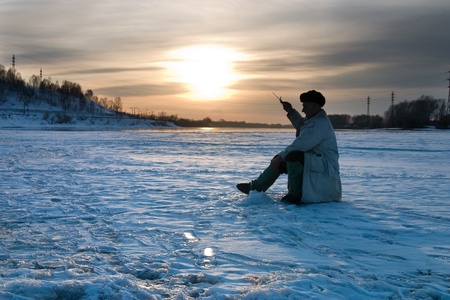1. Understanding Early Spring Water Temperatures
When it comes to fishing in early spring, water temperature is one of the most important factors to consider. Even if the air feels warmer and spring seems to be arriving, lakes, rivers, and ponds often remain chilly from winter’s grip. These colder waters have a big impact on fish behavior, metabolism, and where you’ll find them biting.
Why Water Temperature Matters
Fish are cold-blooded creatures, meaning their body temperature matches the surrounding water. In early spring, as the ice melts and temperatures slowly rise, most game fish are still moving sluggishly because their metabolism hasn’t picked up yet. The difference between 40°F and 50°F water might seem small to us, but for fish like bass or walleye, it can change everything—from how much they eat to where they hide.
How Cold Water Affects Fish Behavior
| Temperature Range (°F) | Fish Activity Level | Common Behavior |
|---|---|---|
| 35–45 | Very Low | Fish stay deep, move slow, rarely feed |
| 46–55 | Low to Moderate | Start moving toward shallows mid-day; short feeding windows |
| 56+ | Active | Feeding increases; more aggressive strikes |
Key Points for Anglers
- Slower Metabolism: Fish digest food more slowly in cold water. They feed less often and may ignore fast-moving lures.
- Lethargic Movement: Most species conserve energy by moving as little as possible. Expect short bursts of activity rather than constant motion.
- Migrating to Warmth: As sunlight warms shallow areas first, some fish will venture into these zones during peak daylight hours. Rocks and muddy bottoms hold heat best.
Tuning In To Your Local Waters
If you’re fishing early spring in places like Minnesota or Michigan, water warms up slower than it does in Texas or Georgia. Use a simple thermometer to check temps near shorelines or drop-offs. This helps you know when fish start getting more active—usually around that magic 50°F mark.
2. Choosing the Right Gear for Cold Water
Picking the Perfect Rod and Reel
When fishing in early spring, water temperatures are still low, making fish less active and more finicky. For these chilly conditions, you’ll want to use a rod with a sensitive tip so you can detect even the lightest bites. Medium-light to medium power spinning rods work great for most cold-water species like bass, trout, and walleye. Pair your rod with a smooth spinning reel that has a reliable drag system—this makes it easier to handle sudden runs from big fish that are sluggish but strong.
Choosing the Right Fishing Line
The type of line you use can make a big difference when the water is cold and clear. Here’s a quick guide:
| Line Type | Best For | Why Use It? |
|---|---|---|
| Fluorocarbon | Bass, Trout, Walleye | Virtually invisible underwater and sinks quickly, perfect for spooky fish. |
| Braided Line (with Fluoro Leader) | Pike, Walleye | No stretch for better feel; add a fluorocarbon leader for stealth. |
| Monofilament | Panfish, Bass | Good stretch for gentle hooksets; floats well for topwater baits. |
Bait Presentations That Work in Cold Water
In early spring’s cold waters, fish are less likely to chase fast-moving lures. Instead, slow down your approach. Try using jigs tipped with live bait or soft plastics—work them slowly along the bottom or near structure. Small crankbaits in natural colors can also be effective if retrieved at a crawl. For live bait fans, minnows and nightcrawlers presented on small hooks will often tempt sluggish fish.
Recommended Lures and Baits Table
| Lure/Bait Type | Presentation Tip | Target Species |
|---|---|---|
| Jig & Soft Plastic Combo | Crawl slowly along bottom or near cover | Bass, Walleye, Crappie |
| Live Minnows/Nightcrawlers | Hook lightly, let it drift naturally with current | Trout, Walleye, Panfish |
| Small Crankbaits (Natural Colors) | Smooth, slow retrieve near structure or drop-offs | Bass, Trout |
| Spoons (Lightweight) | Slow jigging action in deeper holes or pools | Pike, Trout |
With the right gear setup and bait presentations tailored for cold water, you’ll boost your odds of landing some impressive catches this early spring!
![]()
3. Targeting Key Locations
When early spring arrives and the water is still chilly, knowing where to cast your line can make all the difference. Fish are less active in cold water, so they tend to gather in certain spots that offer comfort and warmth as temperatures start to rise. Here’s how you can zero in on those key locations:
Shallows
Shallow areas warm up faster than deeper water when the sun comes out. Early in the season, these spots attract baitfish—and where there’s bait, predators like bass or crappie aren’t far behind. Look for flats near the shore or coves with a gentle slope.
Drop-offs
Fish often move between deep and shallow water during early spring. Drop-offs—where shallow water suddenly gets deeper—act as highways for fish. They’ll hang around these edges to feed while staying close to deeper, safer water if things get too chilly or if they feel threatened.
Sunlit Areas
Any part of the lake or river that gets plenty of sun will warm up quicker. Rocky banks, south-facing shorelines, or places with dark-bottomed substrates absorb heat and become cozy hangouts for fish looking to shake off the winter chill.
Key Locations and Why They Work
| Location | Why It Attracts Fish | What Species to Expect |
|---|---|---|
| Shallows | Warm up fast; attract baitfish; easy feeding ground for predators | Bass, crappie, bluegill |
| Drop-offs | Provide access to both deep and shallow water; good ambush points | Bass, walleye, perch |
| Sunlit Areas | Warmer temperatures; increases insect activity; more active fish | Bass, trout, panfish |
Pro Tip:
If you’re fishing from a boat, use your electronics to find underwater structure near these key locations. From shore? Walk slowly and watch for movement in sunny shallows or along drop-offs—fish can be spooky in clear spring waters.
4. Best Lures and Techniques for Cold Water Bites
Fishing in early spring means you’ll often face cold water and sluggish fish. The right lures, colors, and slow-retrieve techniques can make all the difference in getting those bites. Let’s break down what works best for American anglers during this chilly season.
Lure Selection for Cold Water
When the water is cold, fish are less active and tend to strike at slower-moving targets. Here are some top lure choices that consistently produce results:
| Lure Type | Best For | How to Use |
|---|---|---|
| Jerkbaits | Bass, Walleye, Pike | Pause often between jerks to mimic a dying baitfish. |
| Blade Baits | Multi-species (Bass, Walleye, Trout) | Lift and drop off the bottom with slow rod lifts. |
| Small Soft Plastics (Grubs, Worms) | Panfish, Bass | Drag slowly along the bottom or hop gently. |
| Finesse Jigs | Bass, Crappie | Bounce lightly or drag with minimal movement. |
| Spoons | Trout, Pike, Walleye | Use a subtle lift and flutter retrieve near structure. |
Top Colors for Early Spring Fishing
Cold water is usually clearer, so natural colors work well. However, overcast days or stained water might call for brighter hues. Here’s a quick color guide:
| Water Clarity | Lure Color Recommendations |
|---|---|
| Clear Water | Natural shad, green pumpkin, brown, silver, white |
| Stained Water | Chartreuse, orange, black/blue combos, firetiger patterns |
| Muddy Water | Black, dark purple, bright red or orange accents |
Slow-Retrieve Techniques That Work Wonders
The key to early spring fishing is slowing down. Fish won’t chase fast-moving baits in cold water. Try these proven methods:
- Deadsticking: Cast your lure out and let it sit motionless for long periods before moving it slightly.
- Dragging: Slowly pull your bait along the bottom with pauses every few feet.
- Pendulum Retrieve: Let your lure swing slowly back towards you on a tight line after casting past your target area.
- Lifts and Drops: Gently lift your rod tip to move the bait up, then let it fall naturally—perfect for blade baits and spoons.
Troubleshooting Tough Bites
If you’re not getting bites, try downsizing your lures or switching up colors until you find what works. Sometimes adding scent or using lighter line helps fool cautious fish in clear cold water conditions as well.
Pro Tip: Pay Attention to Sunlight and Structure!
Early spring fish love sun-warmed areas and cover like rocks or fallen timber. Focus on these spots with your slow retrieves for better success in cold water!
5. Staying Comfortable and Safe Outdoors
Early spring fishing can be unpredictable—one minute it’s sunny, the next it’s chilly and windy. Dressing right and making smart choices are key to enjoying your time on the water while staying safe in cold conditions.
Dress for Variable Spring Weather
The weather can change fast in early spring, so layering is your best friend. Here’s a quick guide to dressing for cold water fishing:
| Layer | Purpose | Examples |
|---|---|---|
| Base Layer | Wicks moisture away from skin | Synthetic or merino wool long underwear |
| Middle Layer | Traps body heat | Fleece or insulated jacket |
| Outer Layer | Blocks wind and rain | Waterproof shell or rain jacket |
| Accessories | Adds warmth and protection | Warm hat, gloves, wool socks, waterproof boots |
Staying Warm While Fishing in Cold Water
- Keep hands and feet dry: Cold extremities are uncomfortable and dangerous. Wear waterproof gloves and boots. Bring extra socks just in case.
- Avoid cotton: Cotton holds moisture and can make you feel colder. Stick to synthetic or wool fabrics.
- Pocket hand warmers: These can be lifesavers if temperatures drop unexpectedly.
- Stay active: Move around regularly to keep your blood circulating and body temperature up.
Prioritizing Safety on the Water
- Always wear a life jacket: Cold water shock is real—even strong swimmers can quickly get into trouble if they fall in.
- Fish with a buddy: It’s safer and more fun to have someone with you, especially when conditions are tough.
- Let someone know where you’re going: Tell a friend or family member your plans before you head out.
- Avoid wading too deep: Swift currents and slippery rocks can be more hazardous when the water is cold.
- Pack emergency gear: A first-aid kit, whistle, space blanket, and a fully charged phone should always be part of your gear.
If You Fall In: What To Do?
- Stay calm: Try not to panic—conserve energy and focus on getting out safely.
- Keep your clothes on: They help trap air for insulation until you’re out of the water.
- Get dry and warm immediately: Change into dry clothing as soon as possible and seek shelter if needed.


